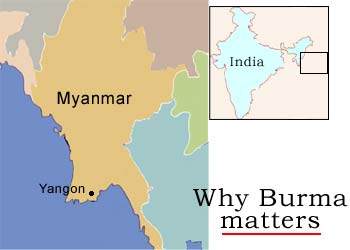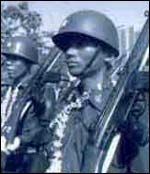
India exists in probably the most unenviable neighborhood in the world.
The countries that surround it are least governed, but that's not because they are in an advanced stage of Marxist development. All around us the institution of State is withering away, in varying degrees, under the weight of ethnic and religious strife, and competing aspirations further exacerbated by the avariciousness and ambitions of leaders.
But not all of them are in similar straits. Bangladesh and Sri Lanka might be closer to India in terms of standards of governance, though that may not be saying too much for them given what is prevalent here. Nepal, Bhutan, Tibet and Pakistan are also caught up in their internal struggles, with few of the institutions that characterise a modern state.
But even by such poor standards Burma would be in a class by itself. It seldom makes the news, but when it does, it is usually for all the wrong reasons.
In recent days it has been once again in the news because of the renewed incarceration of Aung San Suu Kyi, leader of the National League for Democracy and winner of the Nobel Prize for Peace in 1991. The Burmese military junta has taken her into 'protective custody' after a violent incident on May 30 when her motorcade was ambushed in a northern town by as yet 'unknown' miscreants, and in which she is also said to have suffered injuries.
Burmese military intelligence chief Lieutenant General Khin Nyunt has accused her of 'provoking the untoward events.' Suu Kyi has been under arrest for about half the time she since returned to Burma 17 years ago. After her last arrest lasting 20 months she was released in May 2002.
India shares a 1,400-km long border with Burma that runs arbitrarily across forested ridges from Arunachal Pradesh to Mizoram. It's an open border and the tribal people are free to move up to 20 kms on either side. Both countries have made a virtue of a situation over which they have little control, as the political border is made irrelevant by geography and history. Though the majority of the Nagas live in India, a large section lives in Burma. Ditto for the Kukis and Mizos who claim a close relationship with the Chin peoples of Burma.
Historically and culturally the relationship between northeast India and Burma is a particularly close one. The Burmese script derives from Pali, the ancient Indian language before the advent of Sanskrit, and went to them from South India. Buddhism is the principal religion of the dominant Burmans who migrated from Yunnan in China after AD 850 and called their new land their 'Suvannabhumi' or golden land.
Like the rest of South Asia with the exception of Nepal and Bhutan, Burma too was a part of the British Empire and till April 1, 1937 was a part of British India, when the Government of Burma Act separating it from India came into effect. The Burmese interaction with the British began with the conquest of Assam and Manipur by King Alaungpaya (1752-60). For about 70 years Burmese power in the region was unchallenged and blinded by their successes they took on the British in India. The First Anglo-Burmese War (1824-26) ended with the Treaty of Yandabo (1826) by which the Burmese were forced to renounce their claims over Assam and Manipur.
After the Second Anglo-Burmese War (1852-53) that followed the repudiation of the Treaty of Yandabo by King Pagan, Britain annexed Lower Burma and made it a province of India. Upper Burma came under British control when King Thibaw, tacitly encouraged by the French, led his country into the Third Anglo-Burmese War (November 1885), which ended in just two weeks with the capture of all of Upper Burma.
What followed is a tragic tale of how fate deals with losers on the high stakes table. King Thibaw, Queen Supayalat and four princesses were exiled to India, where they were lodged in a dilapidated building on a hill overlooking the Arabian Sea called Outram House in the coastal town of Ratnagiri in Maharashtra. After Thibaw died in 1915, the family's fortunes dwindled and soon they were reduced to penury. His last daughter, Princess Phaya, died in Ratnagiri in 1956. Phaya bore a child, Tu Tu, fathered by the family driver, Gopal. Tu Tu who married a local motor mechanic still lives in Ratnagiri where she ekes out a selling making paper flowers. Her children and their children live in various parts of Maharashtra doing odd jobs. One daughter Jayu Kule lives in Bombay as a domestic servant. Her daughter Prachi is said to bear an uncanny resemblance to King Thibaw. 
Burma, now called Myanmar by the military regime, with a population of about 49.5 million is a land of great diversity. It is made up of 19 major ethnic groups. The dominant Burmans (69%) occupy the rich lands along the Chindwin and Irrawady Rivers that join near Mandalay and flows downwards part Rangoon (now Yangon) into the Bay of Bengal. The other significant groups are the Shan (8.5%) who live in the eastern territory abutting Thailand, Laos and Yunnan province of China, the Kachin (1.4%) who control the northern territory abutting southern China, the Karen (6.2%) who dominate the southern territory alongside Thailand, and the Chin (2.2%) and Rakhine (4.5%) who have common borders with Manipur, Mizoram and Bangladesh. Besides these there are other powerful tribes (5.8%) like the Wa, Karenni and Mon. Most of Burma is densely forested and rich in natural resources, not just jade, rubies, pearls and sapphires, but oil and natural gas. Burma is the world's largest exporter of teak.
The traditional rivalries between the dominant Burmans with the other groups has been the root of all ethnic tensions and has fuelled the country's many separatist rebellions. This tension along ethnic lines is further delineated by the fact that most of the non-Burman ethnic groups have adopted Christianity, while the Burmans still remain largely Buddhist.
Since 1951, the production of narcotics has become a major occupation in the tribal regions abutting China and Thailand, and like elsewhere in the world, the development of narcotics as an industry coincided with the arrival of the CIA in eternal pursuit of its phantom wars. Burma's first drug warlords were these Kuomintang Chinese generals, whose forces the CIA was arming and training to 'retake' China. The drug business then passed into the hands of the tribal warlords like Khun Sha. This is a high growth business and the military regime derives 'taxes' from it by allowing safe havens for their manufacture.
Khun Sha now runs his business from Rangoon. Drugs are easily Burma's principal export, though it is not reflected in the national income accounting. Today Burma produces 84% of the opium in Southeast Asia and most of it in Shan state where the warlord Khun Sha's Mong Tai Army now calls the shots. On June 19, 2002, Mathew Paley, deputy assistant secretary for East Asian and Pacific Affairs in the US State Department, testified to a Congressional Committee that Burma now also produced 800 million metha-amphetamine tablets. It's not without irony that the Americans now spend a fortune trying to break the stranglehold of the drug lords and in interdicting the drug supply chain.
The Americans are great exponents of self-help and like to have their wars financed and fought by others. Drugs have often been the means of self-finance. Most of the stuff produced in what has now come to be called the Golden Triangle ends up in the US, where its main consumers are the black underclass. If there was any moral dilemma about this it seems it was only within the Italian mafia in the US. This dilemma is depicted in The Godfather in the struggle between Vito Corleone and Socorro.
In real life this gang war was fought between Luciano and Maranzano families and was called the Castellmarese War, which was the Sicilian region from which both the gangs hailed. But here in Burma there were no such dilemmas and the CIA decided that drugs should finance the war against Mao's China. But as it so happened by 1971, according to the New York Times (May 16, 1971), 10 to 14% of US soldiers in Vietnam and 7% of all US factory workers tested were addicts.
Ever since the Arabs introduced opium to India in the initial years of the last millennium, the use of opium and its derivatives has driven economies and history with an intensity that proselytizers of religions and ideologies would envy. In the sixteenth century the Portuguese introduced it to indentured Chinese labor in Java. It then spread to China. The East India Company stole the business from the Portuguese and by 1838 Bengal was exporting 2400 tons annually to China. When China attempted to close the trade, the British waged the First Opium War (1839-41) to defend the principles of 'free trade' and 'diplomatic equality.' China then tried to beat imports by allowing opium to be grown in Yunnan. It succeeded.
But when the Communists came to power in 1949, production moved to Burma with the KMT generals driven out of southern China. In 1950 the CIA began regrouping the KMT forces in Shan state for a projected invasion of South China. This trade then expanded to include the generals in Thailand. Drugs, CIA arms and the dense forests have spawned many insurgencies in Burma. Out of the 387 known terrorist and insurgent groups in the world Burma accounts for over 40.
Suu Kyi's father Aung San was one of the founding fathers of the Burmese nationalist movement as well as the Burmese Communist Party. Like Subhas Chandra Bose, Aung San went over to the Japanese side during their occupation of Southeast Asia, including Burma. When Field Marshal Slim's Third Army turned the Japanese back at Imphal and followed triumphantly down the road to Mandalay and then on to Rangoon, Aung San with great alacrity switched over to the British side. With Indian independence looming, the British exit from Burma became inevitable. He then became the leading figure in the newly formed Anti-Fascist People's Freedom League that negotiated Britain's exit from Burma on January 4, 1948.
But Aung San did not live to see freedom for he was mysteriously assassinated on July 19, 1947 as he was presiding over a meeting of the executive council of the Interim Burmese government. Though nationalist leader U Saw was hung after being held by a Special Crimes Tribunal, there are very strong suggestions that General Ne Win and U Nu, the first prime minister, had a more direct hand in the murder and that U Saw was a scapegoat. Interestingly in 1997on the fiftieth anniversary of Aung San's death the BBC2 broadcast a program Who Really Killed Aung San? which strongly hinted a British hand in it. If it was indeed so, it would be a great irony since the British government and the BBC in particular are the greatest proponents of Aung San Suu Kyi.
Since 1962, after U Nu was overthrown, Burma has been under a military government, whose rapacity and cruelty has been matched by a quirky sense of economic nationalism. This economic nationalism -- which has an uncanny similarity to the ideas of the BJP's original swadeshi ideologue, Murli Manohar Joshi -- is a mish-mash of xenophobia with a good bit of mumbo-jumbo like astrology, palmistry and numerology thrown in. In September 1987 Ne Win demonetized currency notes in already quixotic 75, 35 and 25 kyat units and replaced them with 90 kyat and 45 kyat notes, currency units divisible by nine, his lucky number! Nine didn't prove lucky after all for this demonetization triggered off violent protests led by enraged students. The stage was set for the entry of Aung San Suu Kyi.
Tomorrow: Enter Suu Kyi





